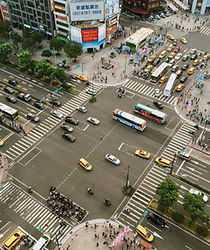
IMPROPER TURN

New York Vehicle & Traffic Law 1163(a) requires motorists making a turn to use the closest practicable lane. On one-way streets, the driver must use the right-most lane (closest to the right curb) to make a right turn and the left-most lane (closest to the left curb) for a left turn. For two-way streets, an eastbound-traveling motorist must use the left-most lane (closest to the yellow lines) for a northbound turn, and vice versa. Sounds simple, of course. But in the hubbub of New York City, many drivers find themselves forced to turn from an improper lane, or deciding belatedly to make a turn. Police officers enforce these violations closely.
Affirmative Defenses to Improper Turns
Drivers often assert that they had no option but to make the improper turn. If you can establish that a traffic condition such as spillback ("blocking the box") forced you to turn from the wrong lane, you might be able to have your ticket dismissed on a justification. Likewise, you might win if you can demonstrate that the lawful turn lane was not available at the time.
Keep in mind, though, that for an affirmative defense, the burden is on the accused to prove the condition they claim. It's very difficult for the driver to show the turn lane was not available at the time. A photograph of the intersection, or your good faith testimony, will probably not suffice. Keep in mind that judges hear these claims all the time. If it were that easy to win your ticket, most people would be found "not guilty" in traffic court. But that is not the case.
If you plan to use an affirmative defense, you will need convincing proof, such as a dash camera video that shows what you actually did at the exact time you were pulled over.
Improper Turns Are Often Paired With Other Violations
In New York City, police officers often summons drivers for improper turns in conjunction with a variety of other charges. If you turn from the wrong lane and also disobey a "no turn" sign, you may get tickets for both improper turn and disobeying a traffic device. If you turn through a crosswalk, you may get tickets for both improper turn and failure to yield to pedestrians. If you do not use a turn signal for your improper turn, you may get tickets for improper turn and failure to signal. There are many other potential pairings with this violation; sometimes a driver may get three or more summonses for one action.
A skilled traffic attorney can minimize the pain you get from receiving multiple tickets at the same time. An attorney may argue that the improper turn is the underlying violation, meaning that the other charges are part and parcel to the improper turn; thus, they should be dismissed. Attorneys know this as proximate cause: "but for the improper turn, the motorist could not have failed yo yield to pedestrians." A traffic attorney knows how to make these arguments, and knows which judges are most likely to find them persuasive.
What To Do If You Get an Improper Turn Ticket
First, plead "not guilty." This is a two-point violation. Then, either go to court on your hearing date or consult with an attorney who can represent you.

